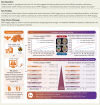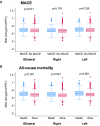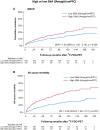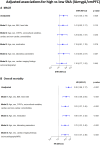Imaging of the brain-heart axis: prognostic value in a European setting
- PMID: 38596850
- PMCID: PMC11089334
- DOI: 10.1093/eurheartj/ehae162
Imaging of the brain-heart axis: prognostic value in a European setting
Abstract
Background and aims: Increasing data suggest that stress-related neural activity (SNA) is associated with subsequent major adverse cardiovascular events (MACE) and may represent a therapeutic target. Current evidence is exclusively based on populations from the U.S. and Asia where limited information about cardiovascular disease risk was available. This study sought to investigate whether SNA imaging has clinical value in a well-characterized cohort of cardiovascular patients in Europe.
Methods: In this single-centre study, a total of 963 patients (mean age 58.4 ± 16.1 years, 40.7% female) with known cardiovascular status, ranging from 'at-risk' to manifest disease, and without active cancer underwent 2-[18F]fluoro-2-deoxy-D-glucose positron emission tomography/computed tomography between 1 January 2005 and 31 August 2019. Stress-related neural activity was assessed with validated methods and relations between SNA and MACE (non-fatal stroke, non-fatal myocardial infarction, coronary revascularization, and cardiovascular death) or all-cause mortality by time-to-event analysis.
Results: Over a maximum follow-up of 17 years, 118 individuals (12.3%) experienced MACE, and 270 (28.0%) died. In univariate analyses, SNA significantly correlated with an increased risk of MACE (sub-distribution hazard ratio 1.52, 95% CI 1.05-2.19; P = .026) or death (hazard ratio 2.49, 95% CI 1.96-3.17; P < .001). In multivariable analyses, the association between SNA imaging and MACE was lost when details of the cardiovascular status were added to the models. Conversely, the relationship between SNA imaging and all-cause mortality persisted after multivariable adjustments.
Conclusions: In a European patient cohort where cardiovascular status is known, SNA imaging is a robust and independent predictor of all-cause mortality, but its prognostic value for MACE is less evident. Further studies should define specific patient populations that might profit from SNA imaging.
Keywords: 18F-FDG-PET/CT; Amygdala; Haematopoietic tissue activity; MACE; Mortality; Psychological stress; Stress-related neural activity; Ventromedial prefrontal cortex.
© The Author(s) 2024. Published by Oxford University Press on behalf of the European Society of Cardiology.
Figures






